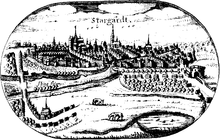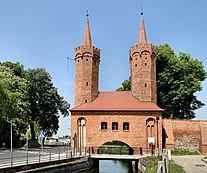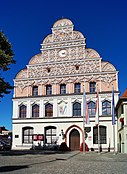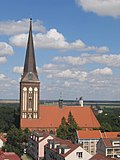| Stargard | |
|---|---|
   From top, clockwise: City Hall, Pyrzyce Gate, St. Mary's Church From top, clockwise: City Hall, Pyrzyce Gate, St. Mary's Church | |
 Flag Flag Coat of arms Coat of arms Brandmark Brandmark | |
| Motto(s): Stargard - Klejnot Pomorza Stargard - Jewel of Pomerania | |
 | |
| Coordinates: 53°20′N 15°2′E / 53.333°N 15.033°E / 53.333; 15.033 | |
| Country | |
| Voivodeship | |
| County | Stargard |
| Gmina | Stargard (urban gmina) |
| Established | 8th century |
| First mentioned | 1124 |
| City rights | 1243 |
| Government | |
| • City mayor | Rafał Zając |
| Area | |
| • Total | 48.1 km (18.6 sq mi) |
| Elevation | 20 m (70 ft) |
| Population | |
| • Total | 67,293 |
| Time zone | UTC+1 (CET) |
| • Summer (DST) | UTC+2 (CEST) |
| Postal code | 73-100 to 73-110 |
| Area code | +48 91 |
| Car plates | ZST |
| Website | http://www.stargard.pl |
Stargard ( ; 1945: Starogród, 1950–2016: Stargard Szczeciński; German: Stargard in Pommern or Stargard an der Ihna; Kashubian: Stôrgard) is a city in northwestern Poland, located in the West Pomeranian Voivodeship. In 2021 it was inhabited by 67,293 people. It is situated on the Ina River. The city is the seat of the Stargard County, and, extraterritorially, of the municipality of Stargard. It is the second biggest city of Szczecin agglomeration. Stargard is a major railroad junction, where the southwards connection from Szczecin splits into two directions: towards Poznań and Gdańsk.
Etymology
The city's name is of Pomeranian (Kashubian) origin and stands for old (stari) town/city (gard or gôrd).
In this meaning, the term gard is still being used by the only surviving Pomeranian language speakers, the Kashubs. However, some experts say that the name is of proto-Norse origin: starn (star) and gate (as in English).
History
Middle Ages

The settlement was founded in the 8th century at the site of the present-day district of Osetno near downtown Stargard. In 967 it became part of the emerging Polish state under the first Polish rulers from the Piast dynasty. Stargard was first mentioned in 1124, when it was part of Poland under Bolesław III Wrymouth. A church was founded in 1140. Stargard received Magdeburg city rights in 1243 from Barnim I, Duke of Pomerania.
It was one of the most important towns and a major trade centre of the Duchy of Pomerania, after it split off from Poland as a result of the 12th-century fragmentation of Poland. From 1283, the city had a port at the mouth of the Ina River in the nowadays abandoned village of Inoujście. Defensive city walls were built in the 13th century and expanded in the 14th, 15th and early 16th centuries. In 1363 the city joined the Hanseatic League.
As a result of the ongoing fragmentation of Pomerania, in 1368 Stargard became part of the Duchy of Słupsk (Pomerania-Stolp) and in 1377 it became the capital of a separate eponymous duchy, which in 1403 fell back to Duchy of Słupsk, a vassal state of the Kingdom of Poland. In 1478 Stargard became part of the reunified Duchy of Pomerania.
In the meantime, the trade rivalry with the nearby city of Szczecin led to the outbreak of the Stargard-Szczecin war in 1454, which ended in 1464. In 1477 Stargard helped Duke Wartislaw X recapture the town of Gartz during a Brandenburgian invasion.
Modern period

Stargard was part of the Duchy of Pomerania until its dissolution after the death of the last duke Bogislaw XIV in 1637. During the Thirty Years' War the city was captured by Sweden in 1630. It was besieged by the troops of the Holy Roman Empire in 1635, and in order to hamper the attacks the Swedish commander set fire to the suburbs, causing a city fire, however, it was still captured by imperial troops. In 1636 it was recaptured by the Swedes, then it was taken and plundered by Imperial troops to fall back to the Swedes again after the Battle of Wittstock. In 1637 it was again captured by Imperial troops and then by Sweden. As a result of the war, the population decreased by about 75%.
In accordance to the 1648 Peace of Westphalia, in 1653 it was incorporated, together with the rest of Farther Pomerania, into Brandenburg-Prussia. In 1701 Stargard became part of the Kingdom of Prussia and in 1818, after the Napoleonic Wars, Stargard became part of the new district Szadzko (then officially Saatzig) within the Province of Pomerania. During the Franco-Prussian War (1870–1871), the Prussians established a prisoner-of-war camp for French troops in the city.
As a result of the unification of Germany in 1871 the city became part of the German Empire. On 1 April 1901 it became an independent city, separate from the Saatzig District. According to the Prussian census of 1905, Stargard had a population of 26,907, of which 97% were Germans and 3% were Poles. During World War I, the Germans operated a prisoner-of-war camp in Stargard, which housed in total some 50,000 POWs, including Russian (including ethnic Poles from the Russian Partition of Poland conscripted to the Tsarist army), French (including Algerians), Belgian, American, English, Serbian, Romanian, Portuguese, Italian and Japanese. In interwar Germany, the town was the site of a concentration camp for unwanted Jewish immigrants from Eastern Europe. The Stargarder Zeitung was as a local newspaper published in Stargard. In the March 1933 German federal election the Nazi Party received 58.7% of the vote in the city.
World War II

In 1939, during the German invasion of Poland, which started World War II, the Germans established the Dulag L temporary camp for Polish (including Kashubian) prisoners of war and civilians near Stargard, which in October 1939 was transformed into the large prisoner-of-war camp Stalag II-D. Then, after the battle of France in 1940, also the French, the Dutch and Belgians were held there, from 1941 also Yugoslavian and Soviet POWs, from 1942 also thousands of Canadians captured at Dieppe, one of whom was Gerald MacIntosh Johnston, a Canadian actor, who was killed trying to escape, and after 1943 also Italians. The POWs were subjected to racial segregation, and Poles, Africans, Arabs, Jews and Soviet troops were separated from POWs of other nationalities and subjected to worse treatment. Serbs also faced more severe treatment.
There were also two subcamps of the Ravensbrück concentration camp, one in Stargard and one in the present-day district of Kluczewo, as well as seven forced labour camps. The Polish resistance organized a district of the Union of Armed Struggle and Home Army in Stargard, under the cryptonym "Starka". Polish underground press was distributed in the city.
In February 1945, one of the last German armoured offensives, Operation Solstice, was launched from the Stargard area. The local population was evacuated by the Germans on the order of Heinrich Himmler before the approaching Soviets in the final stages of the war.
As a result of World War II the town again became part of Poland, under territorial changes demanded by the Soviet Union at the Potsdam Conference. Polish local administration was appointed on March 23, 1945. The town was repopulated by Poles, many of whom were displaced from former eastern Poland annexed by the Soviet Union.
Post-war period
In 1950 the city was renamed Stargard Szczeciński by adding the adjective Szczeciński after the nearby city of Szczecin to distinguish it from Starogard Gdański in Gdańsk Pomerania. In 1961 the city limits were expanded by including the settlement of Kluczewo as a new district.
In 1979 the city suffered a flood.
In 1993 the city celebrated the 750th anniversary of receiving city rights.
In 2004 a north-western part of the town was made into an industrial park - Stargardzki Park Przemysłowy. Another industrial park is located in the south - Park Przemysłowy Wysokich Technologii.
On January 1, 2016, the town was renamed back to Stargard.
Landmarks and monuments
Sights of Stargard Brama Młyńska
Brama Młyńska Renaissance Town Hall
Renaissance Town Hall A Gothic townhouse, today a music school
A Gothic townhouse, today a music school Arsenal
Arsenal Medieval town walls with the Pyrzycka Gate
Medieval town walls with the Pyrzycka Gate St. John's Church
St. John's Church Wałowa Gate
Wałowa Gate War cemetery
War cemetery
Heavy bombing during World War II devastated most of Stargard's fine historical sites and destroyed over 75% of the city. Some of these monuments, such as St. Mary's Church (13th–15th centuries) and the 16th-century town hall, have been rebuilt. The newly restored buildings are on the European Route of Brick Gothic. Some of the notable surviving examples include:
- St. Mary's Church, a distinctive Brick Gothic landmark of the city, dating back to the 15th century, one of the largest brick churches in Europe, listed as a Historic Monument of Poland
- St. John's Church from the 15th century
- Medieval fortifications, including ramparts, walls, gates and towers, also listed as a Historic Monument of Poland, prime examples:
- Brama Młyńska (The Mill Gate) from the 15th century, the only Polish water gate still in existence and one of two in Europe
- Wałowa Gate from the 15th century
- Pyrzycka Gate from the 13th century
- Red Sea Tower (Baszta Morze Czerwone) from 1513
- Weavers' Tower (Baszta Tkaczy) from the 15th century
- White Head Tower (Baszta Białogłówka) from the 15th century
- Gothic tenement houses
- Gothic Arsenal (Arsenał)
Other sites include:
- Renaissance town hall, that has been known as one of the most remarkable examples of 16th-century central European architecture
- Granary (16th century)
- The largest conciliation cross in Europe (1542)
- Bolesław I the Brave Park (Park im. Bolesława Chrobrego), the oldest and largest park in Stargard
- Jagiellonian Park (Park Jagielloński)
- Baroque guardhouse at the marketplace, now housing a museum
- Panorama Park with the Panorama Palace
- Holy Spirit church
- Church of the Transfiguration
- War cemetery where about 5,000 soldiers of various nationalities were buried during World War I and II: Polish, French, Serbian/Yugoslav, Russian/Soviet, Italian, Romanian, Belgian, British, Moroccan, Portuguese and Dutch
- The 15th Meridian Monument (Pomnik 15. Południk)
- Monument to the Victims of Siberia and Katyn
- Monuments of the Polish bards Adam Mickiewicz and Juliusz Słowacki
- Red Barracks (Czerwone Koszary), the largest military barracks in Pomerania
Sport

The city is home to Spójnia Stargard, a men's basketball team, which competes in the Polish Basketball League (the country's top division), 1997 runners-up, and Błękitni Stargard, formerly a multi-sports club, now a men's association football team, best known for reaching the Polish Cup semi-final in 2015.
Demographics



| Year | Inhabitants |
|---|---|
| 1618 | 12,000 |
| 1640 | 1,200 |
| 1688 | 3,600 |
| 1720 | 400 |
| 1740 | 5,529 |
| 1782 | 5,612 |
| 1786 | 6,243 |
| 1794 | 5,971 |
| 1812 | 8,900 |
| 1816 | 8,042 |
| 1831 | 9,907 |
| 1843 | 11,192 |
| 1852 | 12,473 |
| 1861 | 14,168 |
| 1875 | 20,173 |
| 1885 | 22,112 |
| 1900 | 26,858 |
| 1905 | 26,907 |
| 1910 | 27,551 |
| 1913 | 28,000 |
| 1929 | 34,600 |
| 1933 | 35,773 |
| 1939 | 39,760 |
| 1945 | 2,870 |
| 1950 | 20,684 |
| 1960 | 33,650 |
| 1970 | 44,460 |
| 1980 | 59,227 |
| 1990 | 71,000 |
| 1995 | 72,254 |
Notable people

- Karl August Ferdinand von Borcke (1776–1830), Prussian general
- Carl Wilhelm Schmidt (died 1864), missionary
- Oscar Levy (1867–1946), writer
- Max Levy (1869-1932), electro-engineer
- Werner von Blomberg (1878–1946), general
- Georg Joachimsthal (1863–1914), orthopedist
- Hasso von Wedel (1898–1961) Wehrmacht General
- Hans-Joachim von Merkatz (1905–1982) Federal Minister of Justice 1956–1957
- Claus Biederstaedt (1928-2020), actor
- Peter Karow (born 1940), entrepreneur
- Carlo von Tiedemann (born 1943), television presenter
- Arkadiusz Bąk (born 1974), footballer
- Ewa Kasprzyk (born 1957), actress
- Margaret (born 1991), singer-songwriter
- Oskar Dawicki (born 1971), multimedia artist
International relations
See also: List of twin towns and sister cities in PolandTwin towns — sister cities
Stargard is twinned with:
In fiction
In The Cross Time Engineer science fiction series of novels the main character falsely claims Stargard origin to conceal he is a time traveler.
Notes
References
- ^ "Local Data Bank". Statistics Poland. Retrieved 15 August 2022. Data for territorial unit 3214011.
- Brücker, Aleksander (1927). Słownik etymologiczny języka polskiego (in Polish).
oboczne gard zachowały nazwy na Pomorzu (Stargard, 'starogród', ...)
- Kociuba, Jarosław (2012). Pomorze - Praktyczny przewodnik turystyczny po ziemiach Księstwa Pomorskiego (in Polish). Szczecin: Walkowska Wydawnictwo. p. 422. ISBN 9788361805496.
- ^ "O powiecie". BIP Starostwo Powiatowe w Stargardzie (in Polish). Retrieved 30 May 2020.
- Labuda, Gerard (1993). "Chrystianizacja Pomorza (X–XIII stulecie)". Studia Gdańskie (in Polish). Vol. IX. Gdańsk-Oliwa. p. 47.
- ^ "Stargard". Encyklopedia PWN (in Polish). Retrieved 14 February 2020.
- Labuda, p. 52–53
- ^ Grzegorz Podruczny Niezrealizowane projekty twierdzy w Stargardzie, "Stargardia X" (2015), p. 282 (in Polish)
- Kratz, Gustav (1865). Die Städte der Provinz Pommern. Abriss ihrer Geschichte, zumeist nach Urkunden. Berlin. p. 363.
{{cite book}}: CS1 maint: location missing publisher (link) - Podruczny, p. 283
- Kratz (1865), p. 367-368
- ^ Kratz (1865), p. 368
- ^ "Stargard. Historia miejscowości". Wirtualny Sztetl (in Polish). Retrieved 14 February 2020.
- Aniszewska, Jolanta (2011). "W obowiązku pamięci... Stalag II D i formy upamiętnienia jeńców wojennych w Stargardzie Szczecińskim". Łambinowicki rocznik muzealny (in Polish). 34. Opole: 11. ISSN 0137-5199.
- Belzyt, Leszek (1998). Sprachliche Minderheiten im preussischen Staat: 1815 - 1914 ; die preußische Sprachenstatistik in Bearbeitung und Kommentar. Marburg: Herder-Inst. ISBN 978-3-87969-267-5.
- Aniszewska, Jolanta (2019). Nekropolia dwóch wojen światowych (in Polish). Szczecin: IPN. p. 8.
- Stone, Dan (2017). Concentration Camps: A Very Short Introduction. Oxford University Press. p. 31. ISBN 978-0-19-103502-9.
- ^ "Stadtkreis Stargard". Verwaltungsgeschichte.de. Archived from the original on 17 September 2010.
- Aniszewska (2011), p. 9, 14
- Aniszewska (2011), p. 14
- Aniszewska (2011), p. 17
- Megargee, Geoffrey P. (2009). The United States Holocaust Memorial Museum Encyclopedia of Camps and Ghettos 1933–1945. Volume I. Indiana University Press, United States Holocaust Memorial Museum. pp. 1210, 1226. ISBN 978-0-253-35328-3.
- Chrzanowski, Bogdan (2022). Polskie Państwo Podziemne na Pomorzu w latach 1939–1945 (in Polish). Gdańsk: IPN. p. 25. ISBN 978-83-8229-411-8.
- Chrzanowski, p. 57
- "Premier - Kancelaria Prezesa Rady Ministrów - Portal Gov.pl".
- "Stargard Szczeciński | Poland".
- ^ Rozporządzenie Prezydenta Rzeczypospolitej Polskiej z dnia 17 września 2010 r. w sprawie uznania za pomnik historii "Stargard Szczeciński - zespół kościoła pod wezwaniem Najświętszej Marii Panny Królowej Świata oraz średniowieczne mury obronne miasta", Dz. U., 2010, vol. 184, No. 1236
- Wolfgang Schulz (1991). Reise nach Pommern ! Stettin und Umgebung. Die Ostseeküste von Swinemünde bis Leba. Stiftung Deutschlandhaus Berlin. p. 47.
- Kratz (1865), p. 370
- Meyers Konversations-Lexikon. 6th edition, vol. 18, Leipzig and Vienna 1909, p. 857.
- "Miasta partnerskie" (in Polish). Retrieved 13 March 2022.
External links
- Official Website - some materials available in English and German
- Archaeology and history museum
- Satellite photo via Google Maps
| Cities of Poland | |
|---|---|
| 1,000,000+ | |
| 750,000+ | |
| 500,000+ | |
| 250,000+ | |
| 100,000+ | |
| 50,000+ |
|
| 35,000+ | |
| The list includes the 107 urban municipalities governed by a city mayor (prezydent miasta) instead of a town mayor (burmistrz) · Cities with powiat rights are in italics · Voivodeship cities are in bold | |
| Gminas of Stargard County | ||
|---|---|---|
| Seat: Stargard (urban gmina) | ||
| Urban-rural gminas |  | |
| Rural gminas | ||
| Members of the Hanseatic League by quarter, and trading posts of the Hanseatic League | ||||
|---|---|---|---|---|
| ||||
| Wendish |
|   | ||
| Saxon |
| |||
| Baltic |
| |||
| Westphalian |
| |||
| Kontore | ||||
| Vitten | ||||
| Factories | ||||
| Geography of Pomerania | |||||
|---|---|---|---|---|---|
| Regions |
| ||||
| Administration | |||||
| Cities and towns |
| ||||
| Inhabited islands | |||||
| Peninsulae and headlands | |||||
| Rivers | |||||
| Lakes | |||||
| Bays, lagoons | |||||
| National parks | |||||
